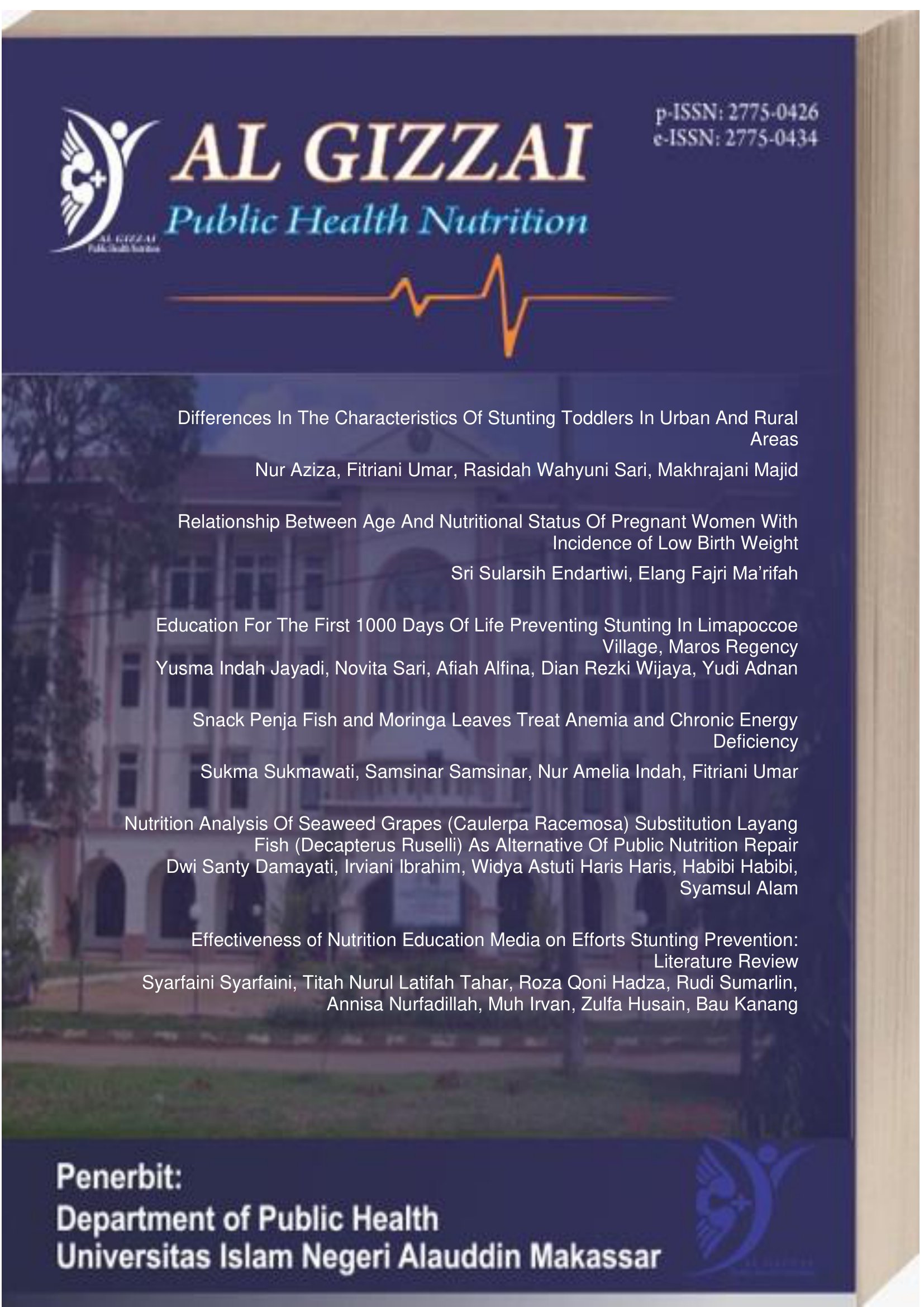Analisis Gizi Rumput Laut Anggur (Caulerpa Racemosa) Subsitusi Ikan Layang (Decapterus Ruselli) Sebagai Alternatif Perbaikan Gizi Masyarakat
Abstrak
Sulawesi Selatan merupakan provinsi tertinggi produksi rumput laut dan Ikan layang merupakan sumber daya ikan pelagis yang mempunyai nilai ekonomis yang memberi kontribusi utama pada produksi perikanan, keduanya memiliki nilai gizi yang sangat baik. Penelitian ini bertujuan untuk mengetahui kandungan zat gizi pada bakso rumput laut lawi-lawi subtitusi ikan layang. Metode yang digunakan yaitu dengan membandingkan antara beberapa formulasi perbandingan rumput laut lawi-lawi dan ikan layang antara lain 100:0, 75:25, 50:50, 25:75, 0:100. Hasil penelitian diperoleh kadar karbohidrat tertinggi pada formula 2 (75:25) sebanyak 29,91%, kadar protein tertinggi pada perlakuan 0:100 sebanyak 20,31%. kadar lemak tertinggi pada formulasi 3 (50:50) sebanyak 11,08%, kadar air tertinggi pada formulasi 1 (100:0) sebanyak 52,5% dan kadar zat besi tertinggi pada formulasi 3 (50:50) sebanyak 24,7860 mg/kg. Hasil uji Anova menunjukkan ada perbedaan antara berbagai formulasi yang signifikan kandungan zat gizi protein, lemak, air dan zat besi namun tidak berbeda nyata pada kadar karbohidrat. Berdasarkan uji organoleptik mutu hedonik menunjukkan bakso rumput laut Lawi-lawi (Ceulerpa racemosa) substitusi Ikan Layang terbaik adalah formula 4 (25:75) berdasarkan warna, aroma, tekstur dan rasa. Penelitian ini menyimpulkan bahwa formula ke 4 (25:75) merupakan formulasi terpilih secara organoleptik merupakan formulasi paling disukai sehingga direkomendasikan untuk melakukan beberapa diversifikasi pangan guna meningkatkan daya tarik masyarakat dalam mengkonsumsi makanan yang baik dan bergizi untuk memperbaiki status gizi masyarakat berbahan pangan lokal.
Referensi
Adriani, Merryana. (2012). Pengantar Gizi Masyarakat. Jakarta: Kencana Prenada Media Grup.avaible at: https://prenadamedia.com/product/pengantar-gizi-masyarakat/
Amalinda F. (2016). Analisis Pola Keluaran Prototipe Sensor Rasa Portable Campuran Lipid Dioctyl Phosphate dan Trioctyl Methyl Ammonium Chloride. Journal Of Saintek 8 (1):20-30. Avaible at: http://dx.doi.org/10.31958/js.v8i1.436
Asrullah M, dkk (2012) Denaturasi dan Daya Cerna Protein pada Proses Pengolahan Lawa Bale (Makanan Tradisional Sulawesi Selatan. Jp Kesmas.avaible at: https://www.e-jurnal.com/2014/11/denaturasi-dan-daya-cerna-protein-pada.html
Bhuiyan dkk (2016), Proximate Chemical Composition of Sea Grapes Caulerpa racemosa (J. Agardh 1873) Colected from a Sub Tropical Coast. Journal Virology & Mycology 5(2) :1-6.avaible at: http://dx.doi.org/10.4172/2161-0517.1000158
Damayati, D. S., Damayanthi, E., Riyadi, H., Wibawan, I. W. T., & Handharyani, E. (2023). The Analysis of Antioxidant Capacities and Sensory in Sea Grapes (Caulerpa racemosa) Powdered Drink as a Therapeutic Obesity. Amerta Nutrition, 7(2), 175–184. https://doi.org/10.20473/amnt.v7i2.2023.175-184
Departemen Kelautan dan Perikanan. (2016). Statistik Perikanan Tangkap. Direktorat Jenderal Perikanan Tangkap Departemen Kelautan dan Perikanan Makassar
Dinas Perikanan dan Kelautan Sulawesi Selatan. (2014). Nilai Produksi Laut Menurut Jenis Ikan Dan Kabupaten Dinas Kelautan Dan Perikanan Provinsi Sulawesi Selatan, Makassar,
Djapiala, F (2012). Kandungan Total Fenol dalam Rumput Laut (Caulerpa racemosa) Yang Berpotensi Sebagai Antioksidan. Depertemen Ilmu Dan Teknologi Pangan. Institut Pertanian : Bogor.avaible at: https://doi.org/10.35800/mthp.1.2.2013.1859
Gulendra I.W. (2010). Pengertian Warna dan Tekstur. Jurnal Seni Rupa, 1: 32 – 34.avaible at: http://repo.isi-dps.ac.id/id/eprint/143
Gosch BJ,MM, Paul NA, de Nys R. (2012). Total lipid and fatty acid composition of seaweeds for the selection of species for oilbased biofuel and bioproducts. journal of gcb bioenergy. avaible at: https://doi.org/10.1111/j.1757-1707.2012.01175.x
Hartono dkk. (2016). “Jurnal Rumput Laut (Keanekaragaman Jenis Rumput Laut Di Perairan Littoral Dusun Tamalabba Desa Punaga Kecamatan Mangarabombang Kabupaten Takalar)”. Pusat Unggulan Ipteks Pengembangan dan Pemanfaatan Rumput Laut (PUI-P2RL): Universitas Hasanuddin.avaible at: https://www.researchgate.net/publication/323084790_Pusat_Unggulan_Ipteks_Pengembangan_dan_Pemanfaatan_Rumput_Laut_PUI-P2RL_Universitas_Hasanuddin
Kumar, J. G. S., Umamaheswari, S., Kavimani, S. & Ilavarasan, R (2019). Pharmacological Potential of Green Algae Caulerpa: A Review. Int. J. Pharm. Sci. Res. VO - 10 10, 1014.avaible at: https://ijpsr.com/bft-article/pharmacological-potential-of-green-algae-caulerpa-a-review/
Khalisa dkk. (2021). Uji Organoleptik Minuman Sari Buah Belimbing Wuluh (Averrhoa bilimbi. L). Jurnal Ilmiah Mahasiswa Pertanian 6 : 594- 601.avaible at: https://doi.org/10.17969/jimfp.v6i4.18689
Kristianawati F. dkk. (2014). Penambahan Enzim yang Berbeda pada Pengolahan Kecap Ikan dari Isi Rongga Perut Ikan Manyung (Arius thalassinus) terhadap Mutu Produk. Jurnal Saintek Perikanan 9. No 2 : 24-32.avaible at: https://doi.org/10.14710/ijfst.9.2.24-32
Ma’ruf, W. (2013) Profil Rumput Laut Caulerpa Racemosa Dan Gracilaria Verrucosa Sebagai Edible Food. Jurnal Perikanan dan Ilmu Kelautan Universitas Diponegoro, 9:1-9.avaible at: https://doi.org/10.14710/ijfst.9.1.68-74
Magdugo dkk (2020) An Analysis of the Nutritional and Health Values of Caulerpa racemosa (Forsskal) dan Ulva fasciata (Delile)-Two Chlorophyta Collected from the Philippines. Molecules 25 (12) : 1-23.avaible at: https://doi.org/10.3390%2Fmolecules25122901
Tamal, M.A dan Aryanto, D. (2018) Efektifitas Ekstrak Bawang Putih (allium sativum L( dalam menghambat Perkembangbiakan Bakteri Escheria coli pada Bakso Sapi. Ziraa’ah 3 (43) :321-331.avaible at: http://dx.doi.org/10.31602/zmip.v43i3.1531
Tapotubun, M.A. (2016) Komposisi Kimia Rumput Laut Caulerpa Lentillifera Dari Perairan Kei Maluku Dengan Metode Pengeringan Berbeda, JPHPI 12 (1): 13-23. Avaible at: https://doi.org/10.17844/jphpi.v21i1.21257
Mukarramah dkk. (2017). Low Fat High Protein Sosis Berbahan Dasar Lawi-lawi (Ceulerpa Racemosa) Sebagai Inovasi Kuliner Sehat Khas Makassar dan Makanan Alternatif Bagi Anak Penderita Obesitas. Jurnal Farmasi. 1:11-19.avaible at: https://journal.unhas.ac.id/index.php/jt/article/view/1445
Slamet, D dkk. (2011). Komposisi Zat Gizi Bahan Makanan Khas Beberapa Daerah di Indonesia. Avaible at: https://www.neliti.com/id/publications/159759/komposisi-zat-gizi-bahan-makanan-khas-beberapa-daerah-di-indonesia
Syarfaini dkk. (2019), Analisis Kandungan zat gizi rumput laut lawi-lawi (Caulerpa racemosa) substitusi tempe sebagai alternatif perbaikan gizi masyarakat. Al-Shihah : Public Health Science Journal 11 (1):94-106.avaible at: https://doi.org/10.24252/as.v11i1.9437
Serpari, S., dkk. (2013). Pengaruh penggunaan es ekstrak ruimput laut, Ceulerpa racemosa, dalam konsentrasi berbeda terhadap mutu ikan laying (Decapterus ruselli). Jurnal Penelitian Gizi dan Makanan. 1:26-39.avaible at: https://doi.org/10.35800/jasm.1.2.2013.7277
Sundari, Dian, dkk. (2015).’’ Pengaruh Proses Pemasakan Terhadap Komposisi Zat Gizi Bahan Pangan Sumber Protein”. Jurnal Media Penelitian dan Pengembangan. 25:12-23. avaible at: https://www.neliti.com/id/publications/20747/pengaruh-proses-pemasakan-terhadap-komposisi-zat-gizi-bahan-pangan-sumber-protei
##submission.copyrightStatement##
##submission.license.cc.by-nc-sa4.footer##Authors retain copyright and grant the journal right of first publication with the work simultaneously licensed under a Creative Commons Attribution-NonCommercial-ShareAlike 4.0 International License that allows others to share the work with an acknowledgment of the work's authorship and initial publication in this journal.
Authors are able to enter into separate, additional contractual arrangements for the non-exclusive distribution of the journal's published version of the work (e.g., post it to an institutional repository or publish it in a book), with an acknowledgement of its initial publication in this journal.
Authors are permitted to publish their work online in third parties as it can lead to wider dissemination of the work.










